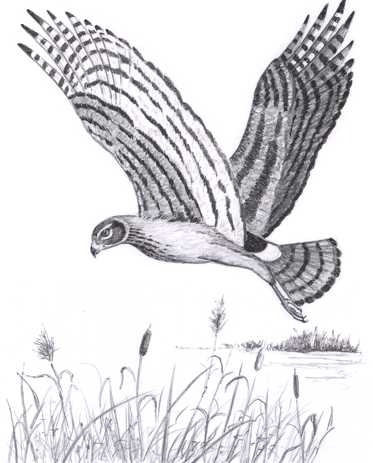
Dear Bird Folks:
Last week I saw a different bird flying over the bog near my house. It was a large, slender, brown bird. It appeared to be hunting as it flew hawk-like, wicked close to the ground. My book tells me it was a Northern Harrier. Could I have seen such a creature?
-Olivia, Marstons Mills
Hold on Olivia,
Didn’t you send us a question last winter? If I remember correctly, it was something about a Great Blue Heron trying survive the winter in your bog. Now eight months later you are back with a question from the same bog. Don’t you ever walk any place else? Ordinarily I won’t answer more than one question from the same bog, but I’m so depressed about Gary Coleman losing the California election, I don’t have the energy to read more than one question this week.
Yes, the bird that you saw was indeed a Northern Harrier (aka, Marsh Hawk for those of you old enough to still call a stereo a hi-fi). Your description was very accurate, which is impressive coming from someone who seems to be bog-bound most of the time.
As their old name, Marsh Hawk, implies, harriers are birds of prey found near marshes, fields and wetlands. You are unlikely to find a harrier in the woods, in the city or even in a backyard. You will also rarely find a harrier sitting in a tree. In fact, you will rarely find a harrier doing anything but flying. A large percentage of a harrier’s day is spent hunting and most of their hunting is done on the wing.
Harriers don’t chase small birds in hot pursuit like Cooper’s Hawks do or sit high on a tree branch, looking for rabbits like a Red-tailed Hawk does. Just as you observed, harriers hunt by flying “wicked” low and slow near the ground. By flying low, harriers not only can see their prey better, they can hear it as well. Harriers have ear holes that are larger than most hawks. They also have a facial disk of feathers, much like owls do, to help direct sounds to their ears. Upon hearing a squeak or rustle, the harrier will drop down for a strike or perhaps stop in mid air and briefly hover, in an effort to locate the prey.
Although harriers don’t have a great sense of smell, if you got close enough you could probably smell them. You see, harriers have an embarrassing problem with mouse breath. I know we all have that problem from time to time, but harriers have it all the time. Ninety-five percent of a harrier’s diet is made up of mice and voles. The remainder of their diet is made up of birds, rabbits and the occasional granola bar.
Here is an odd behavior. When food is plentiful a male harrier may have a small harem and could mate with as many as four females at once. That’s right four. What is he thinking? And, believe it or not, he will provide food for all four nest sites at the same time.
The harrier’s plumage comes in assorted flavors. The females have a speckled belly and a brown back. While the smaller males are mostly gray. (The gray feathers are probably caused from the stress of tending to all of those females.) The immature of both sexes are also brown on the back, but they have a warm pumpkin colored chest and belly. An important field mark to remember is that in every plumage all harriers have a white patch at the base of their tail. Looking like a flying cottontail rabbit, the white patch makes the Northern Harrier one of our easiest birds of prey to recognize.
Just because they are easy birds to ID, doesn’t mean that I’m trying to take anything away from your sighting Olivia. We are still very proud of you. But for the sake of diversity could your next question come from a different habitat? I feel like we are getting bogged-down with your last area.